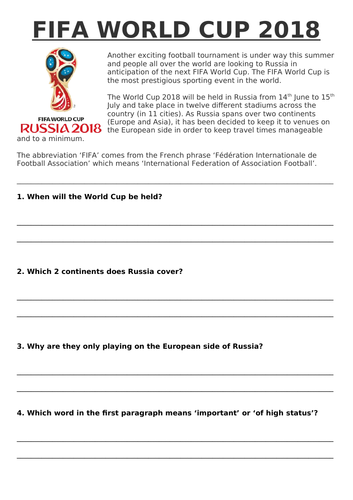










COMPREHENSION
This is a comprehension I made for my year 4 class. There are three different sets:
- one that can be used like a booklet, where the text and questions are on the same page with mostly retrieval questions
- one where the text is separate to the questions and questions are a mix of retrieval and more higher order including vocabulary
- one where the text is separate to the questions and questions are varied from giving evidence from the text to vocabulary questions etc.
I think it can be used with high year 2 as well as KS2.
The actual information text is attached as reading sheet. Both in word and PDF
MATHS
This resource consists of the following five mostly differentiated activities related to the World Cup:
-
Problem-solving lesson with notebook and 3 differentiated sheets. Children design new football kit for their favourite national team consisting of tshirts, shorts (and socks) and find all possibilities of combining them when using 2 (3) colours.
-
Bar chart lesson. Children use data from a Workd Cup table and put it into a bar chart. Differentiated. First bar chart in ones up to 6 and children enter amount of world cups won by different nations. Second bar chart in twos up to 6 and children enter amount of world cups won by different nations. Third bar chart in tens up to 230 where children enter amount of goals scored in world cups for several nations.
All bar charts have at least 5 follow-up questions. First two probably more suited to KS1, last one to KS2. -
Symmetry activity. Children use pictures of flags of all participating teams which are included and sort them into symmetrical and not symmetrical. Included is another sheet on explaining our reasoning - choose two non-symmetrical flags - what would need to be changed so they are symmetrical, explain.
-
Sorting Activity: Children use pictures of flags of all participating teams which are included and sort them using their own criteria into a Venn or Carroll diagram.
-
A quick activity on comparing two flags - how are they the same and how are they different.
-
One activity where children use information on who won the world cup when and put the countries in chronological order by year. One scaffolded sheet and one not scaffolded.
All activities attached as word and pdf files in case the word files don’t open properly.
I SELL BOTH SEPARATELY AS WELL IF YOU WOULD LIKE TO SAVE MONEY.
Something went wrong, please try again later.
This resource hasn't been reviewed yet
To ensure quality for our reviews, only customers who have purchased this resource can review it
Report this resourceto let us know if it violates our terms and conditions.
Our customer service team will review your report and will be in touch.
